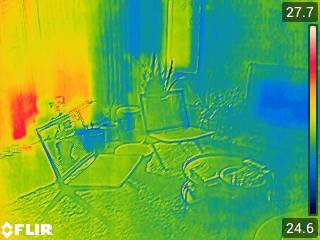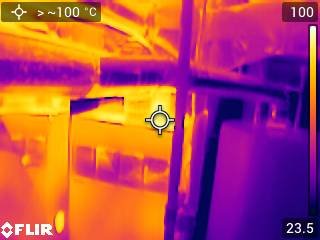Infrared Thermal Imaging
Our home inspectors use thermal imaging in every inspection…
Modern technology to help us understand your home.
IGM & MSX
We use the FLIR building inspection system to inspect all our properties. The thermal imaging camera and moisture meter combine the advantages of Infrared Guided Measurement (IGM) and FLIR’s patented Multi-Spectral Dynamic Imaging (MSX).
Find it.
Infrared technology allows us to detect temperature changes in different materials. As a result, we’re sometimes able to predict conditions in drywall, wood, or insulation, or locate leaks or deficiencies in the home that we can’t normally see with the naked eye.
Target it.
Thermography helps us quickly scan and target problem areas like bathrooms, and ceilings beneath bathrooms and appliances, visually guiding us to the spot where we can confidently take measurements, analyze readings, and ensure that problems are fixed.
Do all home inspectors use thermal imaging cameras?
No. Using a thermal imaging camera to scan a home is beyond the scope of a home inspection and many inspectors choose not to use one. Furthermore, thermal imaging cameras are expensive, averaging $4,000 each.
Does a thermal imaging scan cost more?
Some home inspectors in BC charge extra for an infrared/thermal scan of the property, but we do not. A basic infrared scan is included in all our inspections. Contact us to arrange a more thorough (and time consuming) scan of the home including a scan of all rooms, floors, and hard-to-reach areas inside attics and more.
What do home inspectors find with an infrared camera?
Infrared cameras detect differences in temperature, which can indicate the presence of water or moisture, or the absence of insulation or other building materials. They can also help home inspectors identify common conditions like heat dissipation at windows and doors, underperforming heating and cooling equipment, and electrical or mechanical overheating.
Insulation problems - Missing, wet, or damaged insulation can cause excessive heat loss.
Water - Water ingress and the presence of moisture, which can be detrimental to homes.
Air infiltration and exfiltration - Large gaps in materials, or underperforming doors and windows.
Thermal bridging - Also called cold bridging, heat bridging, or thermal bypass.
HVAC problems - Heating/cooling equipment underperforming.
Electrical problems - Overheating caused by loose connections or incorrect wire sizes.
Termites, wasps & insects - Insect colonies produce heat as a result of the natural activity of hundreds of individual insects.
Pests - Rats and mice produce heat when gathered together and often displace insulation when nesting.
What do you check with the infrared camera?
All our home inspections include the use of an infrared camera to do a basic scan of the home. We do a quick and efficient scan of all ceilings and wall to look for variations in temperature which indicate leaks or problems with insulation.
Can you just scan one part of my home with an infrared camera?
Yes, we provide a single-system scans and leak detection services. Most of the time the use of our infrared camera along with a moisture meter can help us isolate the source of the leak in a wall. Because the camera cannot actually see through walls, invasive investigation (ie. removing drywall) is usually necessary to pinpoint the source, and of course repair the leak.
Does a thermal camera really see temperature?
We strive to make our clients aware of what an infrared camera can do, and also what it can’t. Infrared cameras do not actually measure temperature, they measure radiation. Here’s why: Infrared cameras detect the infrared radiation emitted from only the tiniest, outermost surface of the targeted area. Therefore, infrared cameras don’t detect or measure the temperature of the object itself. The different colours shown in the thermal image represent the different levels of emitted (infrared) radiation as opposed to the actual temperature of the object. The camera’s computer uses mathematical formulas to convert the radiation levels it detects into temperature (a unit of measurement that we are all much more familiar with) .
How much does an infrared camera cost?
Infrared cameras can range anywhere from $500 for a basic accessory-type camera that plugs into your cell phone, to $16,500 for a top-of-the line industrial camera.
Does the camera have X-ray vision?
No, the infrared thermal imaging camera identifies thermal differences. The camera is not an “x-ray vision tool”, so it does not allow the user to see behind or inside walls.




















